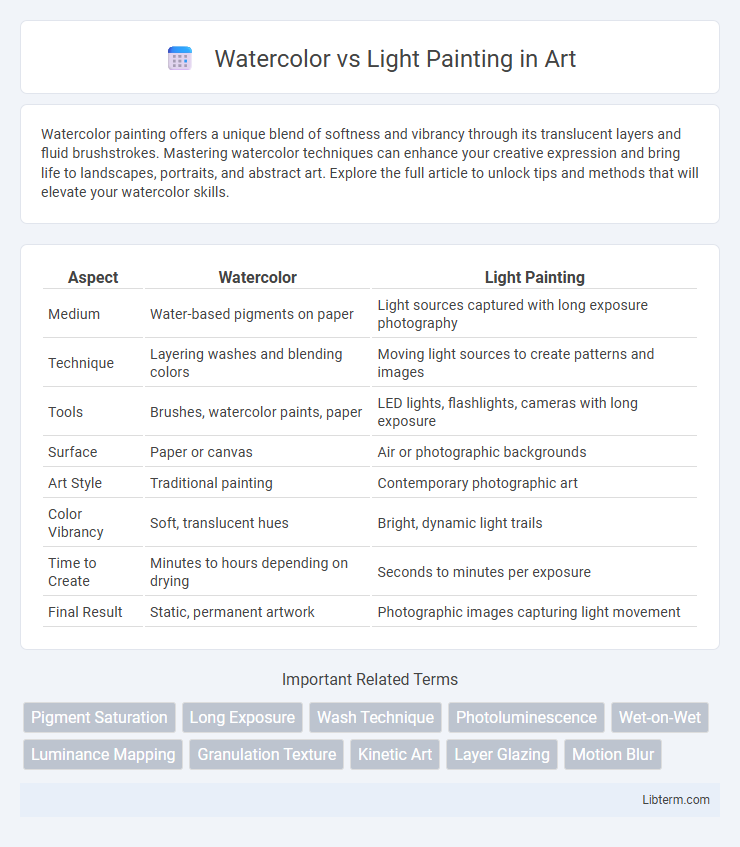Watercolor painting offers a unique blend of softness and vibrancy through its translucent layers and fluid brushstrokes. Mastering watercolor techniques can enhance your creative expression and bring life to landscapes, portraits, and abstract art. Explore the full article to unlock tips and methods that will elevate your watercolor skills.
Table of Comparison
| Aspect | Watercolor | Light Painting |
|---|---|---|
| Medium | Water-based pigments on paper | Light sources captured with long exposure photography |
| Technique | Layering washes and blending colors | Moving light sources to create patterns and images |
| Tools | Brushes, watercolor paints, paper | LED lights, flashlights, cameras with long exposure |
| Surface | Paper or canvas | Air or photographic backgrounds |
| Art Style | Traditional painting | Contemporary photographic art |
| Color Vibrancy | Soft, translucent hues | Bright, dynamic light trails |
| Time to Create | Minutes to hours depending on drying | Seconds to minutes per exposure |
| Final Result | Static, permanent artwork | Photographic images capturing light movement |
Introduction to Watercolor and Light Painting
Watercolor is a traditional painting medium characterized by its translucent and fluid qualities, achieved by mixing pigment with water on paper. Light painting is a photographic technique that uses slow shutter speeds to capture moving light sources, creating vibrant and dynamic images. Both art forms emphasize the manipulation of light and color, but watercolor relies on physical pigments while light painting depends on digital or photographic exposure methods.
Defining Watercolor Art Techniques
Watercolor art techniques involve the use of transparent pigments suspended in water to create delicate washes and subtle gradients that emphasize light and texture. Artists employ methods such as wet-on-wet, dry brush, and glazing to achieve varying levels of opacity and fluidity, highlighting the medium's spontaneity and translucence. Unlike light painting, which captures dynamic light trails through long-exposure photography, watercolor focuses on layered pigment application to evoke depth and atmosphere on paper.
Understanding Light Painting in Photography
Light painting in photography involves capturing long exposure images while moving a light source to create artistic patterns or effects. This technique relies on precise control of shutter speed, aperture, and ISO settings to manipulate light trails and enhance creative expression. Unlike watercolor, which uses pigments and brushes, light painting transforms light itself into a dynamic medium to create visually striking photographs.
Tools and Materials: Watercolor vs Light Painting
Watercolor painting requires brushes, watercolor paper, pigments, and water, emphasizing the fluidity and blending of colors through layers. Light painting utilizes light sources such as LED lights, flashlights, or glow sticks combined with long-exposure photography equipment like cameras with adjustable shutter speeds and tripods. The materials for watercolor are traditional and tactile, while light painting involves digital capturing devices and varying light tools to create dynamic visual effects.
Creative Process: How Each Medium Works
Watercolor involves layering translucent pigments on paper, allowing the colors to blend naturally through water flow and drying times, fostering spontaneity and fluidity in artistic expression. Light painting uses long exposure photography to capture moving light sources, requiring precise control of light intensity, movement, and timing to create vivid, dynamic images. Both mediums rely on experimental techniques and timing, but watercolor emphasizes pigment interaction and absorption, while light painting focuses on manipulating light trails in a dark environment.
Artistic Effects and Visual Impact
Watercolor creates soft gradients and transparent layers that evoke a delicate, ethereal quality with organic textures, while light painting produces dynamic, vibrant strokes of light that emphasize motion and energy in dark environments. The artistic effects of watercolor rely on fluid blending and subtle color transitions, contrasting with light painting's bold, luminous trails that shape visually striking compositions. Visually, watercolor offers a serene and timeless aesthetic, whereas light painting delivers vivid, high-contrast imagery that captures ephemeral light patterns in real time.
Challenges and Learning Curves
Watercolor demands mastery of water control and pigment blending to achieve desired transparency and fluidity, often making it challenging for beginners to predict color outcomes and avoid unintended bleeding. Light painting requires precise coordination of camera settings, light sources, and timing to create clear, intentional patterns in low-light environments, necessitating a steep learning curve in technical photography skills. Both mediums require patience and experimentation, but watercolor emphasizes material manipulation while light painting centers on digital capture techniques.
Popular Artists in Watercolor and Light Painting
Popular artists in watercolor include John Singer Sargent, known for his vivid portraits and landscapes, and Georgia O'Keeffe, who brought bold floral compositions to the medium. In light painting, contemporary artists like Eric Staller and Janne Parviainen have gained recognition for their innovative use of light to create dynamic, long-exposure images that explore motion and space. Both mediums showcase unique artistic expressions, with watercolor emphasizing fluidity and transparency, while light painting highlights the interplay between light and darkness.
Choosing the Right Medium for Your Vision
Selecting the right medium between watercolor and light painting depends on your creative goals and desired effects; watercolor offers fluid, translucent layers perfect for soft, organic visuals, while light painting delivers dynamic, luminous trails ideal for capturing motion and vibrant energy. Watercolor suits projects emphasizing texture and subtle color blending, while light painting excels in experimental, long-exposure photography that captures surreal light forms. Understanding the unique properties of each medium enables artists to better express their vision and achieve the intended emotional impact.
Conclusion: Comparing Outcomes and Experiences
Watercolor offers a tactile, fluid experience with organic blending and subtle color transitions, highlighting the artist's control over pigment and water interaction. Light painting creates dynamic, luminous images that capture motion and time, relying heavily on digital photography and long-exposure techniques for visual impact. Both mediums produce distinct artistic outcomes, with watercolor emphasizing texture and softness, while light painting delivers vibrant, ephemeral effects that engage viewers in a temporal visual narrative.
Watercolor Infographic

 libterm.com
libterm.com